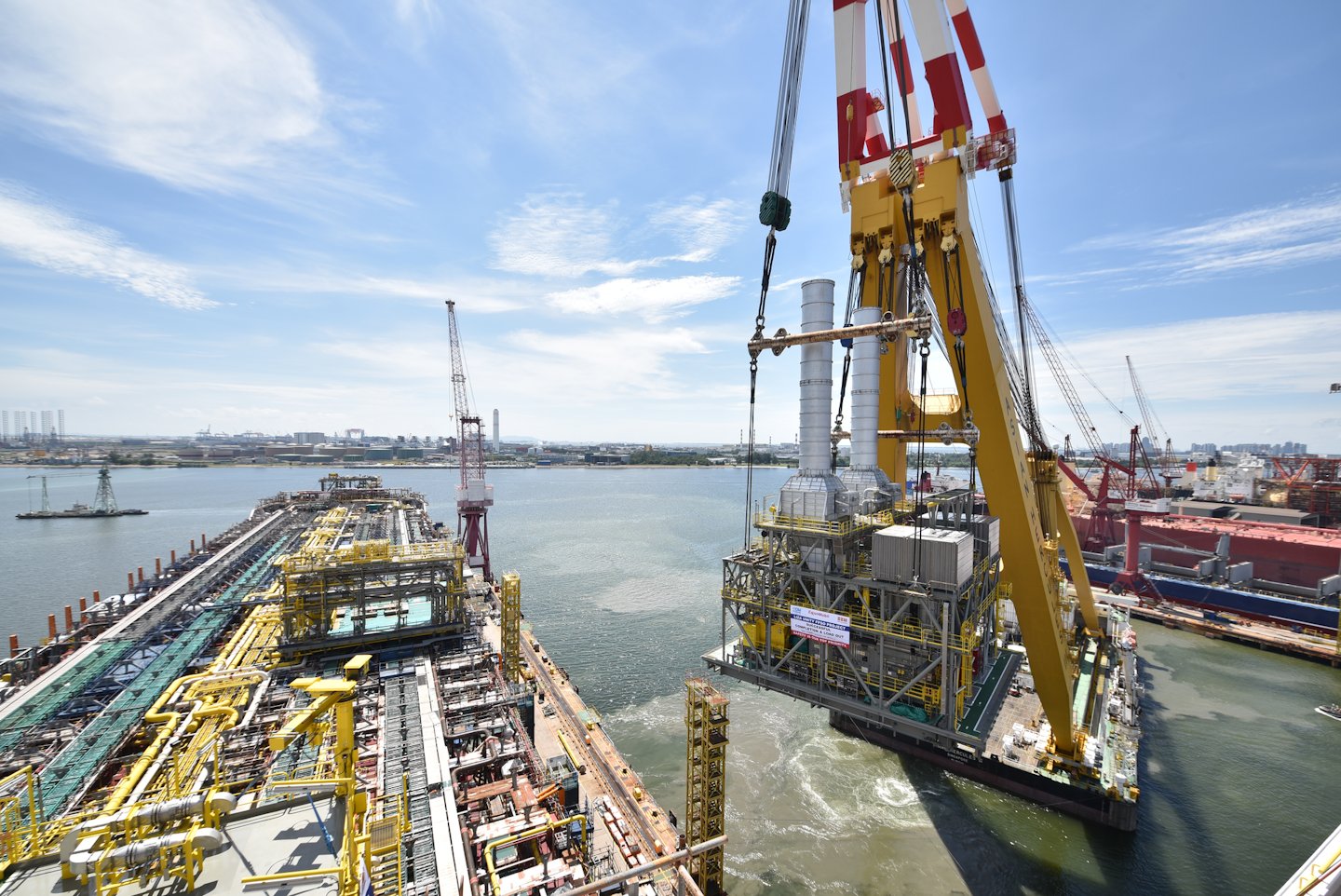FPSO Mac OS
Work Related or Non-Work Related Observation?

The FPSO OSX-1, the first floating production, storage and offloading unit in OSX's fleet, achieved average operating efficiency of 99%, since it began production, on January 31, 2012, for its major client OGX. The production unit is connected to two production wells at OGX’s field Tubarão Azul, in Campos Basin. OSX-1 was built in South Korea and customized at the Keppel shipyard in Singapore, and completed its final test phase in Rio de Janeiro. Measuring 271.75 meters in length, it can store up to 900 thousand barrels of oil. FPSO OSX-1 in numbers: - First floating production, storage, and offloading unit belonging to OSX. - The Sail Away Ceremony took place in Singapore on August 13, 2011. - The 45-day crossing from Singapore to Brazil included a total of 1100 hours of navigation, covering over 16 thousand kilometers at a speed of 8.3 knots. - Eight new modules weighing up to 700 tons each were built; other modules were adapted, and the total project consumed approximately 2 million man-hours. - 3200 tons is the weight of the topside equipment. - 180 kilometers of power cables were installed; if stretched, they would cover the distance from Rio de Janeiro to Macaé. - Over 7000 spots on board are monitored by the automated system. The vessel´s generation capacity of 36 mega watts is sufficient to supply a mid-sized city of 50 thousand inhabitants. - On January 31, 2012, successfully started the first oil production for its major client, OGX. - The unit will begin operating in the Campos Basin to produce the first oil for its major client, OGX. - It has been leased to OGX for a period of 20 years. - The designed production capacity is up to 60,000 BOE per day, and the storage capacity is up to 900,000 barrels. - Funded by a pool of global banking institutions lead by Norwegian DVB Bank, with a total of US$ 420 million. - For the funding operation, the project was awarded the Jane's Transport Finance Awards, in the category 'Shipping Debt Deal of the Year - South America' in London, in 2011, and “Deal of the Year – 2010”, in the “Project Finance” category, offered by the “Marine Money” publication in New York. - International Ship and Port Facility Security Code (ISPS CODE) certification obtained from BUREAU VERITAS. - Granting of ISO 9001, ISO 14001 and OHSAS 18001 certifications by BSI Brasil, a subsidiary of the British Standards Institution (BSI) for the Integrated Management Systemof OSX Serviços, which is the operator of FPSO OSX-1. Name: OSX 1 FPSO Country: Brazil Field Operated By: OSX Year of Completion: The vessel's designed production capacity is up to 60.000 BOE per day, it is 271.75 meters in length and it can store up to 900,000 barrels Keppel: Fabricating, modifying and upgrading the topside process modules BW Offshore: Topside modifications and the delivery of a Submerged Turret Production (STP) system In operation 2012 - First oil produced by the vessel |
- . The FPSO was to operate under charter ‘in Brazil’ for 20 years and should not be treated as a ‘mobile’ asset and the law of the site where the FPSO is located should apply (new form of lex situs). Motion to reconsider decision dismissed in June 2016. Appeal to Superior Court of Justice in Brasilia is pending. OSX 3 case details.
- FPSO OSX-1- It was Keppel Shipyard’s first project for OSX Brasil S.A. It has been chartered by OGX Petroleo e Gas Participacoes S.A. For operations in offshore Brazil. FPSO Aseng- Capable of processing 80,000 barrels of oil per day and storing 1.7 million barrels of oil, it.

Brazilian oil company PetroRio has agreed to buy the OSX-3 FPSO for $140 million, and acquire an 80 percent stake in the Dommo Energia's Tubarao Martelo field off Brazil where the FPSO is currently deployed.
The OSX-3 FPSO was built and delivered to the Tubarão Martelo Field in 2012. It has the capacity to process 100,000 barrels of oil
per day and store 1.3 million barrels.
PetroRio said the acquisition would allow for a 9 km tieback between the Tubarao Martelo and its nearby Polvo field, which would simplify the production system and create a private oilfield cluster.
The company said the move would enable 'significant synergies, lifting cost reductions, and the extension of the useful life of both fields.' 'Once the tieback takes place, the company estimates Polvo’s and TBMT’s combined Opex, which is currently over US$ 200 million per year (US$ 100 million for Polvo + US$ 100 million for TBMT), will be reduced to less than US$ 80 million per year, after having captured these synergies,' PetroRio said, adding that the lifting cost could be reduced to under US$ 16 per barrel as a result of 'air, sea, and land logistics synergies, and the decommissioning of the FPSO currently chartered to Polvo.'
'The cluster’s Opex reduction will allow for a longer-term operation, during which more oil can be recovered. PetroRio estimates the assets’ useful life could be extended to at least 2035 – a 10-year extension- and 40 million barrels added to Polvo’s current reserves,' PetroRio said.
Fpso Osx-3
Leading up to the tieback’s completion, PetroRio will own rights to 80% of TBMT’s oil and will be responsible for 100% of the FPSO’s charter, the Field’s Opex, Capex and abandonment costs. During this phase, the Company will be reimbursed by Dommo at a monthly fee of US$ 840 thousand, equivalent to 20% of Dommo’s current Opex (ex-charter costs).
Fpso Mac Os Update
Once the tieback is completed (estimated for mid-2021), PetroRio will remain responsible for 100% of the abovementioned costs for the cluster, while Dommo will be relieved of the monthly fees. In this new phase, PetroRio will have the rights to 95% of the oil produced by the Cluster up to the first 30 million barrels produced post-tieback, and 96% thereafter.